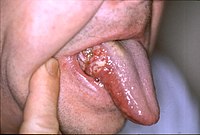
Photo from wikipedia
6054 Background: When combined with COX-2 inhibitors, the EGFR tyrosine kinase inhibitor Erlotinib has shown a better antitumor response in preclinical studies. Since high volume hospitals in many countries usually… Click to show full abstract
6054 Background: When combined with COX-2 inhibitors, the EGFR tyrosine kinase inhibitor Erlotinib has shown a better antitumor response in preclinical studies. Since high volume hospitals in many countries usually have a longer waiting period for surgery, neoadjuvant targeted therapy may be helpful in reducing disease progression and downstaging oral squamous cell cancers. Methods: Sixty-four treatment-naïve operable oral cancer patients were randomized into a four-arm window of opportunity study consisting of treatment with erlotinib 150mg daily, celecoxib 200mg twice daily, the combination of both or observation alone (NCT02748707). Since the regular wait period for surgery at our hospital was four to five weeks, we planned a 21-day drug treatment versus observation followed by definitive surgery in the fourth week. MRI scans and biopsies were done before and after drug treatment. Post-operative adjuvant treatments were given as per the standard guidelines used for regular patients. Results: There were 10 females and 54 males with a mean and median age of 44 and 45 years respectively. Taking a 20% reduction in the maximum tumor dimension after drug treatment (assessed clinically and radiologically) as partial response, the combination arm had a 60% partial response and a 25% stable disease. Whereas, 60% in the control arm had disease progression. The ratio of the longest tumor dimension at day 21 versus day 0 (Clinical & MRI assessment) also showed a significant difference between the observation vs erlotinib arms (p < 0.001) using Mann-Whitney Test. Grade II/III rashes was the commonly observed toxicity predominantly in the combination arm. Though not powered for survival analysis, a significant difference (p = 0.048) was observed for two-year overall survival for celecoxib + control (60%) versus erlotinib + combination groups (86%) using Kaplan Meier estimator. Biomarker analysis (transcriptome sequencing and IHC) is being done on pre and post-treatment tumor specimens and the final results will be presented. Conclusion: Preoperative targeted therapy with erlotinib and celecoxib combination can arrest disease progression and downstage tumors with possible impact on survival. The identified biomarkers can further refine a future cohort for effective neoadjuvant targeted therapy in oral cancers. Clinical trial information: CTRI/2012/07/002828.
Journal Title: Journal of Clinical Oncology
Year Published: 2019
Link to full text (if available)
Share on Social Media: Sign Up to like & get
recommendations!